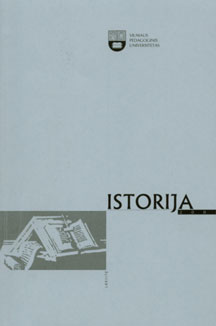Nemiestietiška Vilniaus sociotopografija: valdančiojo elito žemėvalda XV a. pabaigoje – XVI a. pirmojoje pusėje
Sociotopography of Non-Rural Vilnius: Residences of the Ruling Elite at the End of the 15th – the Beginning of the 16th Centuries
Author(s): Aivas RagauskasSubject(s): History
Published by: Vytauto Didžiojo Universitetas
Keywords: Vilnius; the 16th century; land-ownership; sociotopography; residences.
Summary/Abstract: The article analyzes a specific sociotopographic aspect of the city, i. e. town-dwellers’ residence, on the basis of urban land ownership, outside the city boundaries. The example of Vilnius city elite at the end of the 15th and the beginning of the 16th centuries serves as the basis for the analysis. The data proves that till the middle of the 16th century urban land ownership was not legally restricted; therefore, a great number of rich town-dwellers possessed estates of different size and legal status. These estates both provided financial income and served as the places of residence, i.e. their owners lived there for a shorter or longer period of time. This group of people commuted between their estates and Vilnius; consequently, the sociotopography of this elite Vilnius group oversteps the city boundaries. The estates were acquired for the money gained from trade, granting credits to the state and noblemen and customs lease. These estates were also obtained as the ruler’s presents, deposits or rents; finally, they became a permanent possession of a certain group of people. Noblemen, who settled in Vilnius, preserved their land property which was later inherited by their descendents. The estates of the Vilnius elite were mainly concentrated around the city itself as well as around Vilnius, Upytė etc pavietas (an administrative district in Poland, Lithuania etc). They were used for traditional farming, i. e. tributes were collected from the peasants. Some of the larger estates served as the elite families’ residences, to mention Chacutichiai, Jarmolas, Markovichiai, Morshtinai and other families. This territorial migration often meant the rise in a social status, i. e. becoming a nobleman. The author of the article comes to the conclusion that the city’s sociotopography was not identical to the urban one – the latter was considerably wider.
Journal: Istorija. Lietuvos aukštųjų mokyklų mokslo darbai
- Issue Year: 72/2008
- Issue No: 4
- Page Range: 32-39
- Page Count: 8
- Language: Lithuanian

